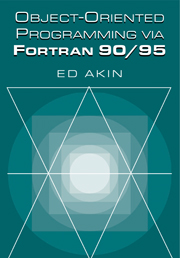Book contents
- Frontmatter
- Contents
- Preface
- One Program Design
- Two Data Types
- Three Object-Oriented Programming Concepts
- Four Features of Programming Languages
- Five Object-Oriented Methods
- Six Inheritance and Polymorphism
- Seven OO Data Structures
- Eight Arrays and Matrices
- Nine Advanced Topics
- Appendix A Fortran 90 Overview
- Appendix B Selected Exercise Solutions
- Appendix C Companion C++ Examples
- Bibliography
- Glossary of Object-Oriented Terms
- Index
Four - Features of Programming Languages
Published online by Cambridge University Press: 15 October 2009
- Frontmatter
- Contents
- Preface
- One Program Design
- Two Data Types
- Three Object-Oriented Programming Concepts
- Four Features of Programming Languages
- Five Object-Oriented Methods
- Six Inheritance and Polymorphism
- Seven OO Data Structures
- Eight Arrays and Matrices
- Nine Advanced Topics
- Appendix A Fortran 90 Overview
- Appendix B Selected Exercise Solutions
- Appendix C Companion C++ Examples
- Bibliography
- Glossary of Object-Oriented Terms
- Index
Summary
The preceding chapter described the programming process as starting with a clearly specified task, expressing it mathematically as a set of algorithms, translating the algorithms into pseudocode, and finally, translating the pseudocode into a “real” programming language. The final stages of this prescription work because most (if not all) computational languages have remarkable similarities: they have statements, the sequencing of which is controlled by various loop and conditional constructs, and functions that foster program modularization. We indicated how similar Matlab, C++, and Fortran are at this level, but these languages differ the more they are detailed. It is the purpose of this chapter to describe those details and bring you from a superficial acquaintance with a computational language to fluency. Today, the practicing engineer needs more than one programming language or environment. Once achieving familiarity with one, you will find that learning other languages is easy.
When selecting a programming tool for engineering calculations, one is often faced with two different levels of need. One level occurs when you need to solve a small problem quickly once, such as a homework assignment, and computational efficiency is not important. You may not care if your code takes 10 seconds or 100 seconds to execute; you want convenience. At that level it may make sense to use an engineering environment like Matlab or Mathematica.
- Type
- Chapter
- Information
- Object-Oriented Programming via Fortran 90/95 , pp. 56 - 118Publisher: Cambridge University PressPrint publication year: 2003

